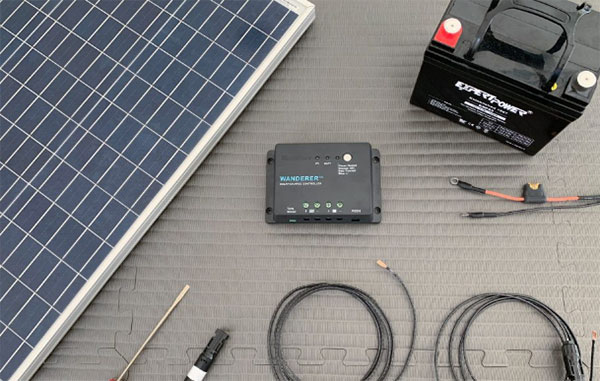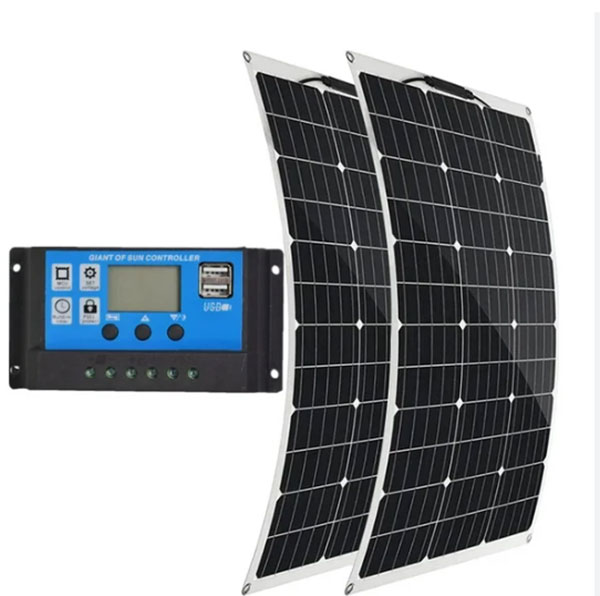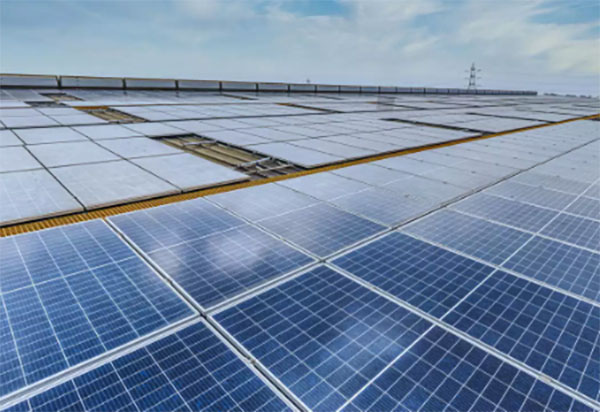Description
A solar charge controller requires compatibility with system voltage, adequate current rating, efficiency, environmental tolerance, and safety certifications.

Fundamentals of Solar Charge Controllers
Definition and Function
A
Solar Charge Controller is a critical component in solar power systems, designed to regulate the voltage and current coming from the solar panels to the batteries. It ensures that the batteries are charged efficiently and safely, preventing overcharging and damage. By adjusting the power input, solar charge controllers maximize the life and performance of batteries. They operate by continuously monitoring the battery voltage and reducing the charge flow as the battery nears its full capacity.
Key Functions:
- Regulate Charging: Protect batteries from overcharging, which extends their lifespan. Typical charge controllers manage voltages in the range of 12V to 48V, depending on the system's design.
- Load Control: Some controllers provide load control, disconnecting the load when the battery is low and reconnecting it when the battery is charged.
- Prevent Reverse Current: At night, when the voltage of the solar panels drops below that of the battery, the controller prevents current flowing back into the panels.
Importance in Solar Power Systems
The importance of solar charge controllers in solar power systems cannot be overstated. They are the heart of the system, ensuring that the batteries are charged properly and protected from damage. This significantly
enhances the efficiency of the solar power system, with MPPT controllers improving efficiency by up to 30% compared to PWM types.
Efficiency and Cost Savings:
- Efficiency: MPPT controllers can convert excess voltage into amperage, which reduces power loss and increases charging efficiency. This efficiency translates to significant cost savings over time, as it maximizes the use of the solar panels installed.
- Cost: The price of solar charge controllers varies widely, from as little as $20 for basic models to over $600 for advanced MPPT controllers. The choice depends on the system's size, complexity, and specific needs.
- Lifespan and Quality: High-quality controllers are designed to last over 15 years, making them a valuable investment in solar power systems. They are made from durable materials that can withstand environmental stress and provide reliable performance over time.

Types of Solar Charge Controllers
Pulse Width Modulation (PWM) Controllers
PWM Controllers are widely used in solar systems due to their simplicity and reliability. They work by gradually reducing the power applied to the batteries as they approach full charge, effectively reducing the charging current to avoid overcharging.
- Cost and Budget: PWM controllers are more cost-effective, with prices ranging from $20 to $200 depending on the features and capacity. This makes them an ideal choice for small to medium-sized solar systems on a budget.
- Efficiency: Although not as efficient as MPPT controllers, PWM controllers still offer an efficiency rate of about 75-80%. They are best suited for systems where the solar panel voltage closely matches the battery voltage.
- Lifespan and Quality: Typically, PWM controllers have a long lifespan, often exceeding 10 years when properly maintained.
- Specifications: PWM controllers are suitable for systems with a power range up to 60 amps of charging capacity, making them ideal for residential solar systems.
Maximum Power Point Tracking (MPPT) Controllers
MPPT Controllers are the most advanced type of solar charge controllers, designed to extract the maximum possible power from the solar panels by adjusting the electrical operating point of the modules or array.
- Efficiency and Power: MPPT controllers can improve charging efficiency by up to 30% compared to PWM controllers. They are capable of handling much higher power inputs, making them suitable for large-scale solar installations.
- Cost: The price for MPPT controllers starts from around $100 and can go up to over $600, reflecting their advanced technology and higher efficiency.
- Lifespan and Quality: With a potential lifespan of over 15 years, MPPT controllers are made from high-quality materials designed to withstand various environmental conditions. Their advanced technology also allows for better management of battery health.
- Specifications: MPPT controllers are ideal for systems with a wide range of input voltages and can handle up to 80 amps of charging capacity, accommodating larger and more complex solar installations.
Comparison and Use Cases
Cost vs. Efficiency: While PWM controllers are more budget-friendly and sufficient for smaller systems, MPPT controllers offer higher efficiency and are better suited for larger, more complex installations where maximizing power output is crucial.
System Size and Compatibility: PWM controllers are best used in systems where the solar panel voltage is similar to the battery voltage. In contrast, MPPT controllers can handle a broader range of voltages, making them ideal for systems with panels that have a higher voltage output than the battery bank.
Use Cases:
- PWM: Best for small residential or portable solar systems where efficiency is less of a concern than cost.
- MPPT: Ideal for commercial and larger residential systems, especially in areas with variable weather conditions, as they can adapt to changing light conditions and maximize energy production.

Selecting a Solar Charge Controller
Selecting the right solar charge controller is crucial for the efficiency, durability, and cost-effectiveness of your solar power system. Here's how to make an informed choice:
Determining the Appropriate Size and Capacity
Size and Capacity: The capacity of a solar charge controller is measured in amps. To determine the right size, calculate the maximum current your solar panels can produce and add a 25% safety margin. For example, if your panels can generate
20 amps, you should choose a controller with at least
25 amps capacity to accommodate for increased efficiency or potential expansion.
- Power Handling: Ensure the controller can handle the total wattage of your solar array. For a system with 240 watts of solar power at 12 volts, you would need a 20-amp controller, considering Watts=Volts AmpsWatts=Volts Amps.
Voltage Compatibility Considerations
System Voltage: Solar charge controllers must match the voltage of your solar panel array and battery bank. Common system voltages are
12V, 24V, and 48V. Some controllers are adjustable or auto-detect the system voltage, which is ideal for systems that might upgrade in the future.
- Compatibility: An MPPT controller is particularly beneficial for systems with a high mismatch between panel and battery voltages, as it can convert excess voltage into current, providing greater flexibility and efficiency.
Features to Look For
Key Features:
- Multiple Charging Stages: Look for controllers that offer at least three stages of charging (bulk, absorption, float) to ensure batteries are charged efficiently and safely.
- Temperature Compensation: This feature adjusts the charge rate based on battery temperature, which is crucial for battery longevity.
- LCD Displays and Remote Monitoring: An LCD display can show vital statistics like voltage, current flow, and battery status. Remote monitoring, available in some models, allows you to monitor and adjust settings via a smartphone app.
- Protection Features: Ensure the controller has built-in protections against overcharging, over-discharging, reverse polarity, short-circuiting, and overheating.
Cost Considerations: While PWM controllers are more affordable, ranging from
$20 to $200, MPPT controllers, priced between
$100 to $600, offer better efficiency and flexibility for diverse systems. The investment in an MPPT controller is often justified by the increased power output and extended battery life in larger or more sophisticated solar setups.
Efficiency and Longevity: MPPT controllers can boost system efficiency by up to
30% under certain conditions. A well-chosen solar charge controller not only enhances the efficiency but also significantly extends the life of the battery bank, providing substantial long-term savings.

Installation Requirements for Solar Charge Controllers
Installing a solar charge controller is a critical step in setting up a solar power system. Proper installation ensures optimal performance, safety, and longevity of the system components. Here's what you need to know:
Pre-Installation Checks
Inspect Equipment: Before installation, inspect the solar charge controller and all other system components for any damage. Ensure you have the correct model that matches your system's voltage and current requirements.
Confirm Compatibility: Verify that the solar charge controller is compatible with the solar panels and battery bank in terms of voltage and current capacity. For instance, a 24V system requires a controller that supports 24V operation.
Understand System Specifications: Familiarize yourself with the specifications of your solar setup, including the total power output (
watts), system voltage (
volts), and maximum current (
amps). This will guide the selection and installation process.
Step-by-Step Installation Guide
- Mount the Controller: Securely mount the solar charge controller in a location that is dry, well-ventilated, and protected from direct sunlight. The mounting area should also allow for easy observation and operation.
- Connect the Battery Bank: First, connect the battery bank to the charge controller. This ensures that the controller correctly recognizes the system voltage. Use appropriate cable sizes to handle the expected current flow, typically ranging from 4mm2 to 10mm2 for most installations.
- Connect Solar Panels: After securing the battery connection, connect the solar panel array to the controller. Ensure the total voltage and current from the panels do not exceed the controller's capacity.
- Connect Loads (if applicable): If the controller has load control features, connect the DC loads to the controller's load terminal. Ensure the total load does not surpass the controller's rated output capacity.
- Configure Settings: Adjust the controller settings according to your battery type and system requirements. This may include setting the charging voltage, load disconnect voltage, and other parameters relevant to your system.
Safety Measures and Best Practices
- Use Correct Tools and Equipment: Always use the right tools for the job, including insulated tools and protective gear, to prevent accidents.
- Follow Manufacturer's Instructions: Adhere strictly to the installation guide provided by the manufacturer.
- Ensure Good Ventilation: Charge controllers can generate heat during operation. Install them in well-ventilated areas to prevent overheating.
- Regular Maintenance: Regularly check connections for corrosion or looseness and inspect the controller for signs of wear or damage. This helps in maintaining the efficiency and safety of the system.
- Professional Assistance: If unsure about any aspect of the installation, seek professional help.

Maintenance and Troubleshooting for Solar Charge Controllers
Ensuring your solar charge controller operates efficiently over its lifespan involves regular maintenance and being able to troubleshoot common issues. Here s a comprehensive guide:
Routine Maintenance Guidelines
Visual Inspections: Conduct bi-annual inspections of your solar charge controller to check for any visible signs of wear, damage, or loose connections. This simple step can prevent many issues related to poor connections or environmental damage.
Clean Connections: Dust and debris can accumulate on the connections and terminals, leading to poor conductivity. Use a dry cloth to clean these areas gently. Ensure that all connections are tight and corrosion-free.
Monitor Performance: Use a monitoring system, if available, to track the performance of your solar charge controller. Look for any sudden changes in output, which could indicate a problem.
Common Issues and Solutions
Battery Not Charging: If the batteries are not charging properly, check if the solar panels are generating power and if the connections to the controller are secure. Also, verify that the controller settings match the battery specifications.
Overheating: Solar charge controllers can overheat if installed in poorly ventilated areas or if the current flowing through the controller exceeds its capacity. Ensure adequate ventilation and check that the system does not exceed the controller s rated power.
Erratic Behavior or Fault Codes: Many controllers have diagnostic features. If the controller displays error codes or behaves erratically, consult the manual for specific troubleshooting steps. A reset might be necessary to clear any glitches.
Upgrading and Replacement Tips
When to Upgrade: Consider upgrading your solar charge controller if your system expands or if newer models offer significantly better efficiency or features that match your system's needs. MPPT controllers, for instance, offer better efficiency and might be worth the investment if you're expanding your solar array.
Choosing a Replacement: When selecting a new controller, consider the future expansion of your system, compatibility with your existing setup, and features such as remote monitoring or programmable settings. Ensure the new controller can handle the maximum voltage and current from your solar array.
Installation: When replacing or upgrading your controller, carefully remove the existing unit and ensure all power sources are safely disconnected before installing the new controller. Follow the manufacturer's installation guide closely to avoid any damage.
Cost Considerations: While PWM controllers are more affordable, with costs ranging from
$20 to $200, MPPT controllers, priced between
$100 to $600, offer greater efficiency for larger or more complex systems. The investment in an MPPT controller can be justified by the long-term savings in energy efficiency.

Technical Specifications and Compliance for Solar Charge Controllers
Understanding the technical specifications and compliance requirements is crucial when selecting a solar charge controller. This ensures your solar power system operates efficiently, safely, and in accordance with international standards.
Electrical and Mechanical Specifications
Voltage and Current Ratings: Solar charge controllers are typically available for 12V, 24V, or 48V systems, with current ratings ranging from 10A to 80A. Selecting a controller with the correct voltage and current rating is crucial to prevent system failures.
- Maximum Power Point Tracking (MPPT) controllers are more versatile, capable of handling higher voltages and converting excess voltage into additional current, enhancing system efficiency.
- Pulse Width Modulation (PWM) controllers are simpler and must match the system's voltage closely.
Efficiency: MPPT controllers offer efficiencies up to
98%, maximizing the energy harvested from the solar panels. PWM controllers, while less efficient, still maintain efficiencies around
75-80%.
Physical Dimensions and Weight: The size of solar charge controllers varies, with more robust models being larger due to their higher capacity and additional features. Compact controllers are preferable for small installations or limited spaces.
Environmental Tolerance: Quality controllers are designed to operate in a range of environmental conditions, typically from
-20 C to +60 C. Enclosures rated at IP65 or higher offer protection against dust and water, essential for outdoor installations.
Connectivity and Monitoring: Advanced controllers feature connectivity options such as Bluetooth or Wi-Fi, allowing for remote monitoring and configuration via smartphone apps or web interfaces.
Compliance with International Standards
IEC and UL Certifications: Compliance with International Electrotechnical Commission (IEC) standards, such as IEC 62109-1, and Underwriters Laboratories (UL) standards, like UL 1741, assures safety and performance. These certifications indicate that the controller has undergone rigorous testing for electrical safety, efficiency, and reliability.
RoHS and CE Markings: Controllers should also comply with the Restriction of Hazardous Substances (RoHS) directive, ensuring they are free from specific hazardous materials. CE marking signifies compliance with EU safety, health, and environmental requirements.
ISO Quality Standards: Manufacturers that adhere to ISO 9001 quality management standards demonstrate a commitment to consistent quality and continuous improvement, enhancing product reliability and customer satisfaction.
Key Considerations: When selecting a solar charge controller, it's important to balance cost with features and performance. While MPPT controllers are more expensive, with prices ranging from
$100 to $600, their higher efficiency and adaptability to varying voltages may offer better value over time, especially for larger systems. PWM controllers, costing between
$20 and $200, are a cost-effective solution for smaller, simpler systems.









